There is something magical about a great bowl of Japanese ramen noodle soup. It’s absolutely wonderful. If you’ve never had good ramen go out and get some.
Just do it. Today. Noodles. Broth. Pork. Egg. Wow. If the noodles are the backbone, the tonkotsu ramen broth is the heart and soul.
This is the first step towards a good bowl of tonkotsu ramen
This is a descent into madness. I’m making the tonkotsu ramen broth from scratch. I’m cooking pork belly. I now know the difference between the 7 minute and 7 1/2 minute egg.
I’ve figured out how to make spaghettini into the alkalinated noodles. I’ve replicated the Momofuku pork belly. Got a lesson in their kitchen for that. For real. The rest of the tonkotsu ramen recipe is here.
All this work so I can maybe come close to the $13.00 bowl of ramen at my local ramen joint. Crazy. Follow me only if you are crazy too. Or you just love ramen as much as I do. Turns out it’s pretty easy. And it’s delicious. Good living.
Making tonkotsu ramen broth is a real eye opener. If you know how to make classic French meat stocks forget everything you know. This broth is cooked at a roiling boil for 12 hours.
A rolling boil. The absolute antithesis of the French technique.
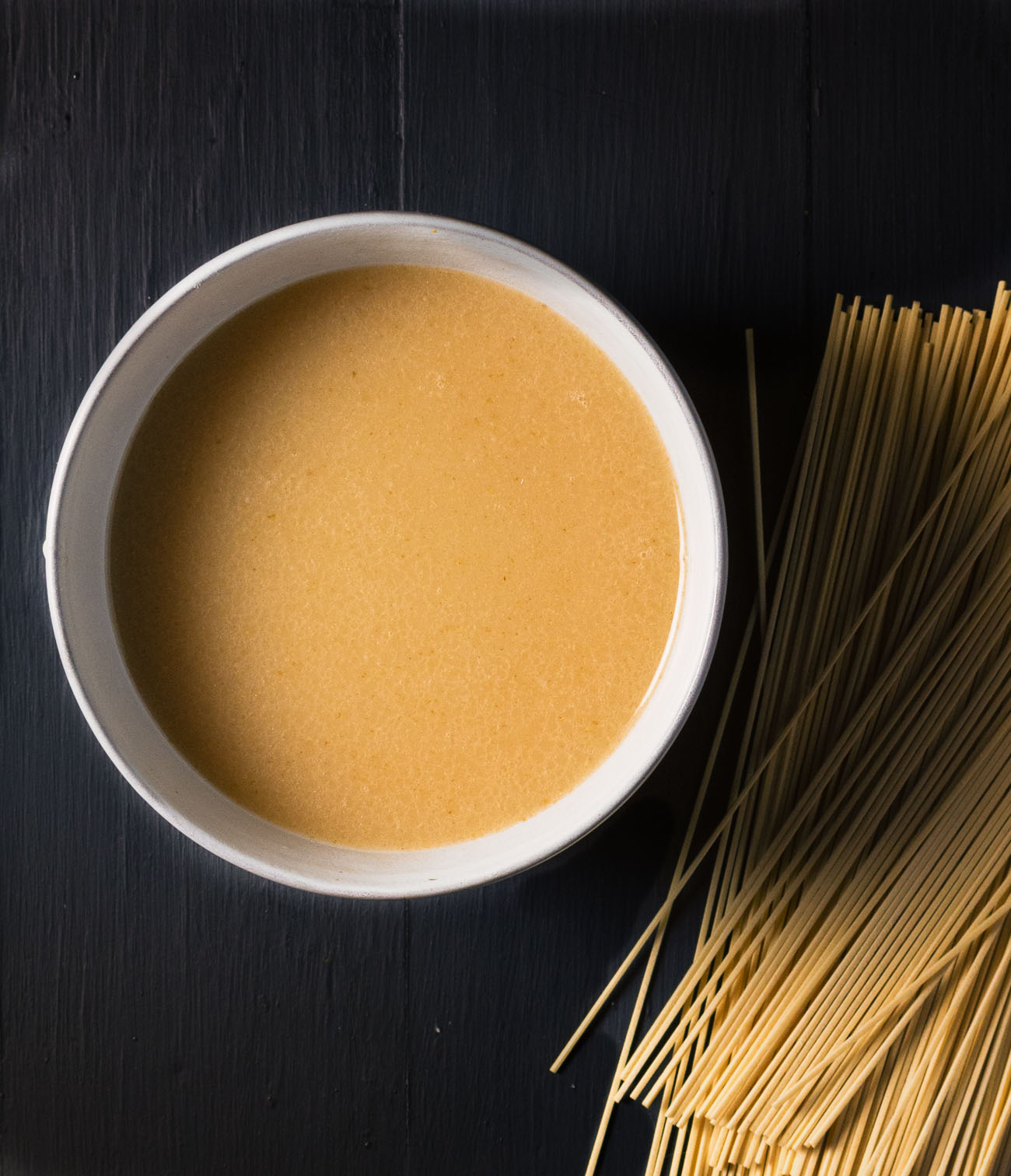
The bones of the matter
I like pork neck bones for tonkotsu broth. It’s not make or break though. You just want bones with a bit of meat on them. Adds flavour.
And you probably don’t want to pay a fortune for them. At least I don’t. Anything that fits that description will work.
I go to my local Asian grocer. Buy neck bones. They always have them. I know they work. And they are cheap. Perfect.
Clean bones is the key to a good tonkotsu ramen broth
There’s a lot of Asian technique here that you don’t see in classic western cooking. Blanching the bones is a big one.
And a really good one. Add all the bones to a pot. Bring to a boil. Cook for about 5 minutes. Then dump it all out and rinse the bones.
I’m not a fan of putting flavour down the sink. But in this case it’s genius. Doesn’t make a difference to the end flavour.
But it does get rid of all that muck floating on the surface of the stock. Muck that would get boiled into the stock. Muck that would likely ruin the broth. Did I mention this is genius?
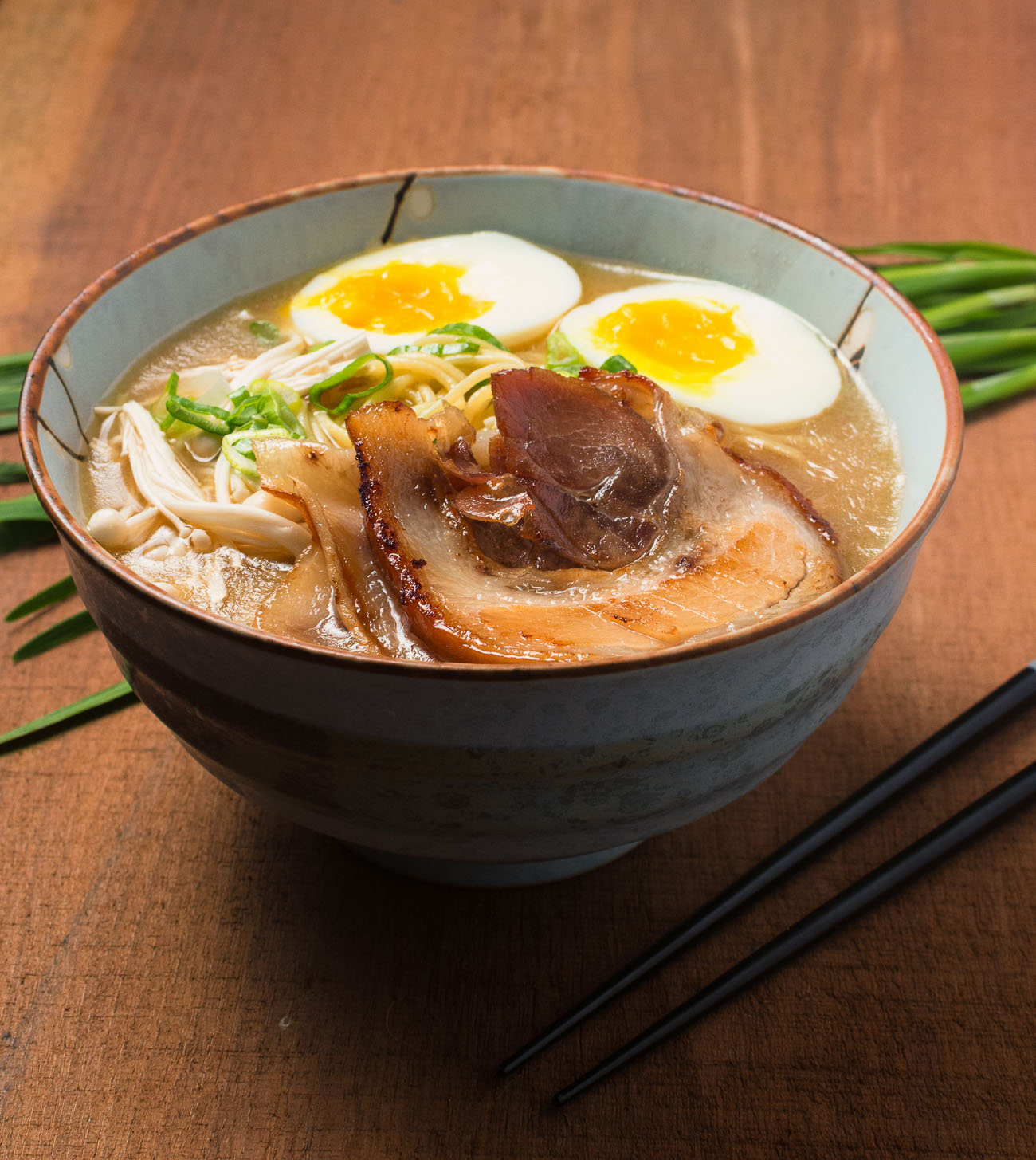
A rolling boil makes a magical broth
Something happens when you cook pork bones at a rolling boil. All the gelatin and fat and goodness comes out of the bones and turns the stock that milky white colour.
If nothing else, this experience was absolutely fascinating. Just make sure you keep adding water to keep the bones submerged.
Don’t use a slow cooker for this. Won’t work. People have tried. They have failed. Read the comments below…
To cover or not to cover?
You can find videos on youtube of Japanese ramen joints making their broth. Huge pots of stock boiling away. They don’t cover their pots. But they have staff in the kitchen full time.
You can try it uncovered if you are planning to hang out in the kitchen all day. Your call. I don’t though. A loosely covered lid keeps some of the evaporation in check.
You still need to pay attention though. You are maintaining a rolling boil for 12 hours. Covered or not it can boil dry. And that’s a whole world of hurt nobody needs.
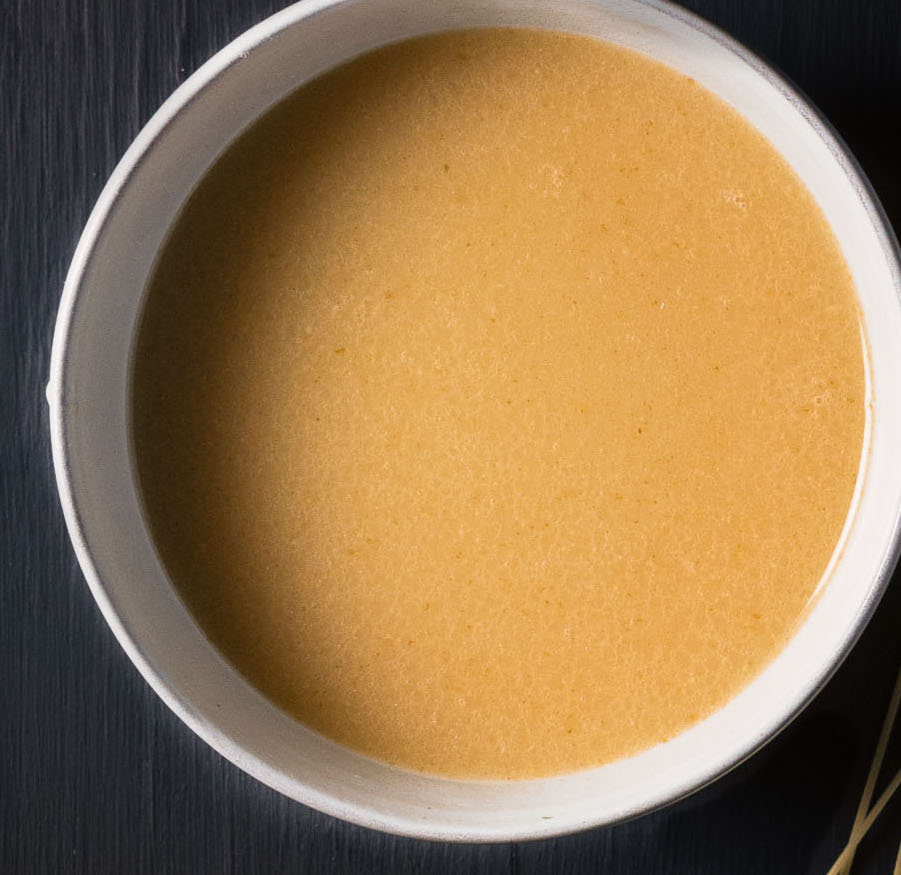
No more secrets
This ramen broth is delicious. This part is nailed. Nothing to it really. Just need to follow the recipe. No secrets here. Not anymore. The tonkotsu ramen turned out pretty amazing too.
This is base. The foundation to a great bowl of ramen. You can make just about any tonkotsu style ramen with it. Next step is the tare. That’s what pushes it in different directions. Shio. Shoyu. Miso. Your choice.
Tonkotsu ramen broth. Not the quickest way to make something great. But so totally worth it.
tonkotsu ramen broth at home
Ingredients
- 6 lbs pork bones with a little meat on them. Pork neck bones work well.
- 4 oz white mushrooms sliced
- 1 onion peeled and halved
Instructions
- Place the pork bones in a large stock pot and cover with cold water.
- Bring to a rolling boil over medium high heat. At this point a huge mess of scum will form.
- Remove from heat. Dump the water and carefully rinse all the bones under cold running water.
- Return the bones to the stock pot. Cover the bones with cold water and bring to a rolling boil.
- Add the mushroom and onion and maintain a rolling boil for 12 hours, replenishing the water along the way. You want to keep the bones under water the whole time. It’s best to cover the pot for this or you’ll be adding water every 30 minutes.
- After 12 hours, remove the stock from the heat and cool slightly. Remove the bones with a slotted spoon and strain the stock.
- The stock will keep in the refrigerator for 2-3 days or can be frozen at this point.
- The broth is flavoured by the tare of your choice. There are two good one’s in the tonkotsu ramen recipe.


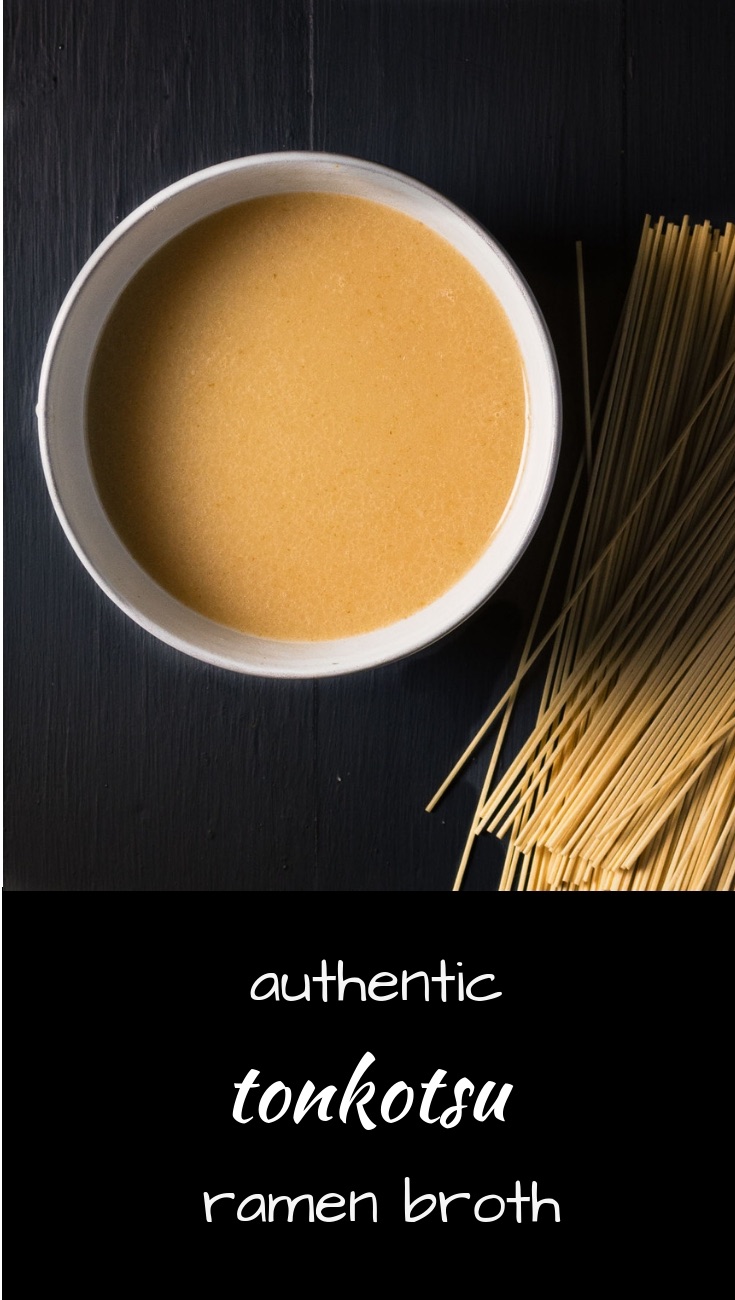
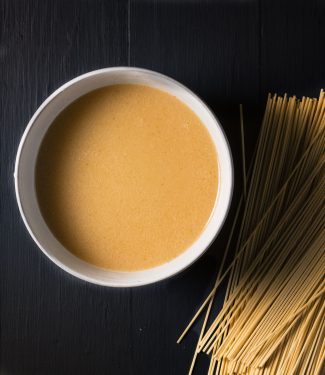
I’ve made this recipe twice and both times it turned out amazing. So much flavour and very straight forward and easy to make. The colour of the broth after 12-16 hours is something to write home about
Loved it. Can’t wait to make more of your recipes.
I’m so glad you liked it. I’m a huge fan of tonkotsu ramen and it’s not easy to get a good bowl where I live. Hope you find more recipes you enjoy!
BRAH.
That’s on my list next.
Nice!
Uh, real question about timing.
I would like to have this go overnight but how the heck can this be done safely???
Thinking of starting on the stove, blanch, then transfer to slow cooker/ pressure cooker overnight then back to stovetop in am.
7:30 pm start time, aiming for dinner 5 pm tomorrow. So would be about 10 hours on stovetop in am too..?!
I’ve never tried that. Pressure cooker might work. Might go too fast. I don’t know. Sorry. As brave as I am I would never let my stove (or stand-alone pressure cooker) run hard overnight.
I would start it in the evening. Stay up late. Put it in the fridge overnight and set my alarm to get up early to put it on again.
My Tonkotsu broth didn’t have ramen noodles. Yup, I tried another version. I added vermicelli instead and the dish was still delicious. There’s no doubt that the broth is the heart and soul of noodle soup. Thanks Romain!
You are very, very welcome!!!
In middle of making this now, one tip to add in (or maybe I missed it)…make sure to stir the pot every 30 or 40 minutes in the second half of the boil, otherwise your bones will burn and stick to pan like mine! Still gonna finish but pretty sure it won’t taste great, I can smell the char. I used neck bones, but also my power burner so maybe there is a thing as too high heat here
Wow. I don’t understand how you got char in a pot of boiling water. The instructions do say to keep the water obove the level of the bones throughout. You must have one serious power burner. That’s not something I’ve ever seen or even thought possible.
Certainly though, if it happened to you then it could happen to someone else so this is a good tip. Better safe than sorry.
I am very sorry to hear your bones burned. I’m pretty sure you are right. If you can smell the char it isn’t going to be good.
Hi, my husband and I just did this in our instant pot and came out delicious very rich and creamy. I know that you can’t have a rolling boil in an instant pot, but it dissolved almost everything. We have done it on the stove too and the flavor is the same. Thanks for the delicious recipe.
You are very welcome! Did you use the pressure cooker setting on your Instant Pot?
More details, please? What setting did you use? How long? Thanks!!
Hello, I’m trying this on Saturday along with your ramen recipe. I made the mistake of not buying enough pork bones. I realized my package is only 3.15lbs. But, I have 1lb of pork Neck and 1 lb of pork skin that I had set aside to make soup dumplings. So that gets me up to 4.15lbs of bone, is the skin useless or can I put some in there and just fill up the water a bit more? Thank you.
I have never tried using skin but suspect it would just add an awful lot of fat and not much flavour…
This is awesome ? I’ve made tonkotsu ramen once before following the No Recipes recipe, and I made the mistake of trying to do it all in one day. It turned out well but I got discouraged after that attempt because of all the work, but reading this makes me wanna make it again! And keep ready-made ingredients in the fridge for future use ?
You go! And the best part is, if you freeze it, you can have ramen any time you want!
This looks awesome, I’m going to try and adapt it for my slow cooker
I’m a bit concerned by that. The whole recipe relies on a long, rolling boil. Can you achieve that in a slow cooker? I don’t have one so I don’t know too much about them…
Update: it was sooooo good! Making it again tonight. Thanks so much for the post!
Awesome to hear! I love tonkotsu ramen!
Love the broth! Every single drop of it. Thanks for this magical recipe! My family loved them. One question though, have little broth left from the last batch, could this be refrigerated for 4-5 days? Will it still be good? Thanks again!
Glad you liked it! It’s real work but it’s so worth it.
I don’t know if I would push it 5 days. It would be such a shame if it went off. But it freezes well. Why not just pop it in the freezer to be safe?
Or it eat up tomorrow:-)
I have made this, following the instructions pretty well – but I had mainly pork trotters. I was not super wowed by the results. I suspect it might be the bones used, but the broth was brownish and quite gloopy (too much collagen?), although the flavor was good. Too rich to my taste. Maybe I should have diluted the end result a bit? Anyhow, I might try it again subbing half to pork for chicken bones. I’d like to achieve the milky, pale yellow broth I love so much from a ramen shop.
Sorry it didn’t work out for you but it’s not surprising. Pork trotters are extremely rich and not what I would ever think of when I read “bones with some meat” as specified in the recipe. I will add a note to make sure nobody else makes this mistake. If you do try again, try pork neck bones if you can get them.
After boiling the bones for 5 minutes and then draining them, should I take off all scraps of fat and meat? As in, should the bones be completely bare of anything on them before boiling them for 12 hours?
Leave the scraps on the bone. There’s tons of flavour there. Just boil, rinse and go.
Hi! I just boiled this overnight on the stove and can’t wait to make ramen tonight!
Question: should I skim the fat off the top? I used pork bones, chicken wings and chicken feet, and there appears to be a pretty good fat cap on the pot now.
Thanks!
It depends on your tolerance to fat. I like a little bit personally. I would skim it off and then add a bit back in to each bowl to taste when you serve.
Can the bones have to much meat on them? I think mine had plenty and my stock was very bland/watery, even though I boiled it for 14 hours. It went hard in the fridge so I’m pretty sure I got all the gelatine out of the bones. I got about 4 cups of stock out of it so that should not be the problem.
If it went hard in the fridge it has the gelatin. I am afraid I have no idea why it is watery at this point. It shouldn’t taste like full blown ramen (the tare has a lot to do with it) but it should have flavour.
Hi! My boyfriend can not have mushrooms, is there a chemistry cooking magic thing that requires them, or can I skip it? (He can have enoki, but that doesn’t seem like what the recipe is looking for.) Thanks! (And I am really excited about trying this…)
Mushrooms add a bit of umami but I think you can leave them out and it will still be good. Have fun!
Hoping I have done this correctly! It’s 12 hrs up now and it’s very white/milky but the taste to me is like watery pork. Hard to explain it. I’m not sure what I was expecting I guess, as I have never done this before. Hoping it all comes together once I add my tare. I’m so invested right not! Ha!
It shouldn’t taste watery. Maybe you could reduce the liquid a bit (evaporation) until it starts to taste more strongly of pork? The colour sounds right.
I’ve made this broth once before with your chashu pork belly recipe and we are in love. We have been craving ramen so I’m making it again. I am a huge garlic fan so I am going to add a couple cloves of garlic to it and see how that turns out. I am also making homemade ramen noodles and excited to see the results. Thank you for sharing a delicious recipe.
Awesome. You could maybe add the garlic flavour to the tare rather than the broth? That way you could adjust the amount of garlic on a per bowl rather than per batch of broth basis. Just a thought. I’m sure it will be fantastic either way.
Love this recipe; seems easy enough.
Have you ever used a pressure cooker (InstaPot) to cook this?
Great to hear. Thank you.
I’ve never tried a pressure cooker so I don’t know exactly how it would turn out. Please do let everyone know how it turns out if you try it.
I have a pretty good ramen book that talks about a pressure cooker. It’ll reduce your cooking time to 7 hours total including prep time, instead of 12+. Boil and rinse the bones as normal, chilling in the fridge for at least 3 hours to ‘set’ things up. Place in the pressure cooker, cover with two inches of water (distilled or filtered if you have metallic tasting tap water), lock the lid and cook on high for two hours along with the onions and mushrooms. After 2 hours remove the lid from the pressure cooker (after carefully releasing the pressure of course) and either transfer to a stockpot and boil for another 2 hours, or bring to a boil right in the stockpot. You want a full boil now, for at least two hours, or until the bones have given up almost all of their connective tissue and marrow. Strain and chill as normal. Good luck!!